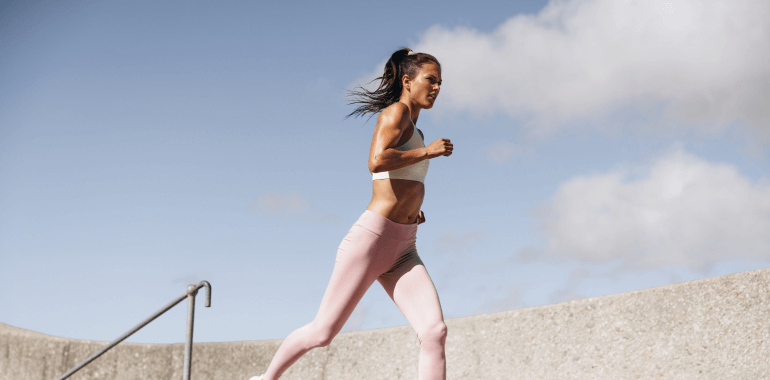Table Of Contents
Is it possible to exercise while fasting? This is one of the most common questions newcomers have regarding intermittent fasting. This is a valid question when you consider fasting reduces your food intake and you require energy for most workouts. However, this begs the burning question, “Is it safe to exercise while fasting?”
This article will teach you all there is to know about intermittent fasting and exercise. So continue reading.
Introduction
Have you ever considered incorporating intermittent fasting while still performing a workout routine? If so, congratulations – you’ve taken the first step toward unlocking the incredible potential of your body and mind.
So let’s understand exactly why working out while fasting has such amazing rewards!

Can You Workout While Fasting?
The answer is YES. You can work out while fasting. However, you need to be doing more fasting to help you achieve your wellness goals, whether it be losing weight, boosting immunity, leading a healthy lifestyle, etc.
The benefits of intermittent fasting are becoming more well-recognized than before. Adding workouts to the mix can help you leverage these advantages and push things to the next level. Don’t forget that exercise offers its own set of benefits on its own. As a result, exercising during fasting is quite advantageous.
You risk losing muscle and fat if you don’t exercise while following any weight-loss plan. The goal of any weight loss program, including intermittent fasting, is to burn fat and maintain muscle mass. As a result, if you don’t exercise, your body may believe you don’t need your muscles and begin to break them down.
Working Out While Fasting: How It Can Help?
Working out while fasting can provide excellent results for those wishing to lose weight or enhance their general fitness. Fasting triggers the release of hormones in the body, which help to burn away stored fat more quickly and efficiently than at rest
This means that if you work out during a fasted state, your fat-burning potential is increased. Additionally, as your body burns fat for energy, it helps to create a caloric deficit that can lead to weight loss over time.
- Working out while fasting can cause fatigue or dizziness due to decreased blood sugar levels. To avoid these side effects, listening to your body and ensuring you drink enough fluids throughout the day is essential.
Additionally, it’s best not to exercise at high-intensity levels during fasting as this can put too much stress on the body and could be dangerous. Instead, focus on moderate-intensity workouts like walking or yoga, which will help you reap the benefits of fasting without overtaxing your system.
Intermittent fasting and a moderate amount of running also can help you reach your fitness goals. Doing both together can help create an optimal metabolic environment for weight loss, improved muscle endurance, and increased fat burning.
Also, read – What to Do Before Working Out
Do Exercises Differ While Fasting?
Exercises are generally different during fasting. First, because intermittent fasting necessitates eating only during specific hours, you must determine when your workout will be most efficient. Most people do this first thing in the morning when they’ve just gotten out of bed because that’s when they’re most enthusiastic. However, this can vary from person to person.
During fasting, you’ll also need to limit the intensity of your workouts. While there are benefits to working out during fasting, there’s a limit to how much you should push your body to avoid injury or bodily harm.
When to Work Out During Intermittent Fasting
Morning is the ideal time to work out when fasting. This is because you are utilizing energy first thing in the morning, and your sleep cycle doesn’t get disrupted. Exercising close to bedtime has been demonstrated to disrupt sleep cycles, so depending on your schedule, it’s best to work out in the morning or afternoon.
After your workout, you should wait two to three hours before eating. This allows you to get the most out of fasting activities, such as hormone optimization (working out while fasting makes you more insulin sensitive). As a result, Human Growth Hormone (HGH) aids in fat-burning and muscular growth therefore, whenever you choose to workout, wait 2-3 hours before eating.

Fasting After Workout for Different Goals
Fasting after a workout can have different effects depending on your specific goals. Here are a few scenarios:
- If your primary goal is losing body fat, fasting after a workout can enhance fat burning. In addition, by delaying your first meal after exercise, you can extend the time your body relies on stored fat as a fuel source.
- Fasting immediately after a workout may not give your body the necessary nutrients, such as protein and carbohydrates, for optimal muscle repair and growth. You may feel dizzy if you wait too long after a workout.
- For individuals focused on improving athletic performance or endurance training, there may be better options than fasting immediately after a workout. Proper post-workout nutrition helps replenish glycogen stores essential for sustained exercise energy and muscle building.
Also, read – Does Eating Rice Crispy Before Workout Really Help?
Can You Build Muscle While Intermittent Fasting?
Yes, you can build muscle while intermittent fasting! This is because intermittent fasting has some benefits in building muscle due to the hormones released. Fasting triggers the release of growth hormones and other hormones that help promote muscle growth. It also helps with protein synthesis, which is vital for building and maintaining muscle. Intermittent fasting can also help reduce inflammation, which is essential for tissue repair and recovery after workouts.
What Happens if I Workout Without Eating?
Working out without eating can have positive and negative effects on your body, depending on the type of activity, the intensity of the workout, and your overall health. For example, not fueling your body with enough food before training can lead to energy loss, reduced muscle mass, or even injury.
On the other hand, working out without eating can help you burn fat more quickly if done in moderation. Therefore, understanding how not having food before a workout affects your body is crucial so you can make an informed decision regarding exercise and nutrition. This may take trial and error as you learn more about your body!
What Exercises Are Allowed During Fasting?
While you may want to do anything your body can manage while fasting, keeping your workouts low-intensity is recommended. If you overwork yourself while fasting, your body may begin to break down muscle for energy, which is the opposite of what you want.
If you still want to work out at a moderate to high intensity, do so throughout your eating window, especially after you’ve broken your fast. Because moderate and high-intensity workouts demand more energy, they’re best done immediately after or during your feeding periods so you can utilize the most energy for your workout. eating.
You may also do all your workouts during the eating window if that’s your only free time to exercise. Remember to listen to your body and not overwork yourself. Stop working out if you start to feel exhausted or lightheaded.
Low-intensity workouts like walking, yoga, moderate pilates, and low-intensity cardio are suitable while fasting. However, weightlifting and other high-intensity exercises are best done after a meal.
Also, read – How to Get the Energy to Workout
Diet is Key – Refuel on Protein After Your Workouts
Intermittent fasting is all about timing when you eat, as everyone who has tried it knows. However, you must focus on what you are consuming during your feeding periods to get the most out of your fasting schedule. Fasting attempts can be ruined by overeating or consuming harmful foods.
Protein, healthy fats, and high-fiber carbs should all be included in your fasting meal plan. These foods provide everything your body requires and will help you recover from your workouts as well as stay full during fasting periods.
Stay hydrated – Hydration is Everything
Make sure to stay hydrated during fasting. Drink enough water, unsweetened tea, coffee, and other non-caloric beverages.
Exercising in a Fasted State: How to Fuel Your Body
Start by hydrating well before your workout. Drink water or other non-caloric fluids to ensure you’re adequately hydrated.
Plan your workout for when you have the energy and focus for physical activity. For example, someone finds that morning exercise works well after a good night’s sleep.
While you may exercise on an empty stomach, consuming a small, easily digestible snack before your workout can provide energy. Opt for foods rich in carbohydrates and moderate in protein, such as a piece of fruit or a handful of nuts.
After your fasted workout, you must replenish your body with nutrients for recovery. This can help fill glycogen stores and support muscle repair and growth.
Potential Cons of Working Out While Fasting
There are potential adverse effects of exercising while fasting, and they include the following:
Poorer performance: Studies suggest that intermittent fasting could decrease the performance of highly trained athletes. So, athletes should thoroughly evaluate intermittent fasting before doing it.
Struggle to build more muscle: If your goal is to build muscle, there may be better options than intermittent fasting. Fasting is more effective at burning fat and maintaining muscle mass.
Lightheadedness: Exercising while fasting can lead to dangerously low sugar levels or blood pressure. And this can cause lightheadedness and cause you to faint. So, if you’re feeling lightheaded, stop your exercise session.
Cardio vs. Strength Training Workout While Fasting
While fasting, cardio workouts, especially low-intensity ones, are safe. Running while fasting will help you burn fat and attain your wellness objectives more quickly. It’s recommended to undertake cardio close to mealtime so that you may refuel afterward. You should ideally wait 2-3 hours after cardio before eating however, if you are feeling lightheaded, refuel sooner after your workouts. Intermittent fasting can be paired with strength exercises, such as lifting weights. Remember to plan to eat before working back-to-back workouts. Your physical capabilities and personal preferences determine the type of workout you undertake. If you’re not feeling particularly energized, a short walk will suffice. The trick is to pay attention to your body and avoid overexertion.
Working Out While Fasting 48 Hours: Try or No?
Exercising while fasting for 48 hours is an extreme approach that can pose risks and challenges to your body.
It’s generally only recommended with proper medical supervision. Extended fasting periods can lead to significant energy depletion and dehydration, impairing exercise performance and compromising well-being.
Fasting for an extended duration can cause muscle breakdown and negatively impact your metabolism. It may also lead to a decline in cognitive function and an increased risk of injury. Moreover, intense workouts during an extended fast can put excessive stress on your body, potentially adversely affecting your cardiovascular system and overall health.
Intermittent Fasting and Working Out at Night: Is It Good Idea?
Generally speaking, working out upon waking (or shortly after) helps support your body’s natural circadian rhythm. This means you get a workout before eating, so your energy levels can remain at their peak throughout the day.
Exercising too close to bedtime can disrupt the quality of your sleep.
Research shows that exercising before bed can negatively impact long-term health by interrupting deep and REM sleep levels. So if you want to make sure you get enough restful sleep each night, save exercise for the following day.
Also, read – Does Intermittent Fasting Slow Metabolism?
Intermittent Fasting and Hiit – Special Considerations Before Starting
Fasting is recommended as a therapeutic approach for chronic, non-infectious conditions. Consult your healthcare provider if you would like to consider fasting for any of these purposes.
In addition, exercising while fasting positively affects the breaking down of fat in your adipose tissue. This, in turn, encourages fat burning and can contribute to weight loss.
- According to this study, engaging in a specific 10-minute exercise protocol, which incorporates 3 minutes of high-intensity exercise, has been found to have notable benefits for skeletal muscle oxygen consumption and cardiometabolic health. Even a short, intense exercise can significantly impact your body’s ability to consume oxygen and improve cardiovascular and metabolic well-being.
To put it in simpler terms, when you do high-intensity interval training (HIIT) while fasting, your insulin levels decrease. This allows your body to tap into its fat stores and use them for energy.

16/8 Intermittent Fasting Morning Workout: How to Practice Effectively
Consistency is the key to making the 16/8 intermittent fasting t successful to work out in the morning and consider other healthy habits. Make it part of your daily routine and stick to it. Set aside a specific time for your training each day so that it becomes an ingrained habit. It doesn’t need to be lengthy — just 20 – 30 minutes of exercise can benefit your body and health positively. Consistency is key!
Focus on performing exercises that target both large and smaller muscle groups; this will help build strength and endurance throughout the body. Remember to stretch too!
- Incorporate light stretches at the beginning and after your workout routine to promote mobility and flexibility in the muscles and joints.
A 16/8 intermittent fasting morning workout isn’t a race! You don’t have to rush through it or push yourself too hard.
It’s okay to take a rest between sets, rest for a few minutes, then start again when ready. But, most importantly, enjoy the process of exercising and learning — make it fun by finding activities that are interesting and enjoyable for you!
Also, read – How Pedometer Can Help You Reach Your Goal
Strength Training While Fasting – Read Before Start
Exercises involving resistance are used in strength training, also known as resistance training or weightlifting, to increase muscle strength and endurance. Contrarily, fasting usually means depriving oneself of food and calorie-containing liquids for a set amount of time.
You might be surprised to learn that intermittent fasting doesn’t cause your muscles to disappear, especially when incorporating weightlifting into your routine. Instead, research suggests that combining intermittent fasting with resistance training helps you maintain your muscle mass in addition to losing fat.
It’s worth noting that only one study shows significant muscle gains while doing intermittent fasting and strength training. Interestingly, the participants in that study ate more than usual, but over time, it resulted in weight gain for them.
Here’re a few things to think about can you lift weights while fasting:
Energy Availability
During fasting, your body’s energy stores, primarily glycogen (stored glucose), become depleted. Strength training requires energy, and if you don’t have enough energy available, it may affect your performance and recovery. Therefore, ensure you have enough energy reserves before engaging in intense workouts.
Muscle Protein Synthesis
Strength training promotes muscle protein synthesis, which is crucial for muscle growth and repair. Adequate protein intake is necessary to support this process. If you’re fasting for an extended period, consuming enough protein within a restricted eating window may be challenging, potentially affecting muscle recovery and development
Personalized Approach
The effects of strength training while fasting can vary among individuals, depending on factors such as overall health, fitness level, and fasting duration. It’s essential to consider your specific circumstances and tailor your approach accordingly. Consult a fitness professional when needed.
Precautions
If you’re new to fasting or strength training, it’s advisable to start gradually and listen to your body. Then, monitor your energy levels, recovery, and overall well-being. If you experience any adverse effects, adjusting your fasting or training routine may be necessary.
Final Thoughts
Exercising while fasting has certain benefits. The key is to keep the intensity of your workouts low. Ultimately, you know your body better than anyone else, and you shouldn’t push yourself too hard while exercising during fasting.
Sign up for our newsletter for the fasted weight training articles and information on improving your health and lifestyle.
Educate yourself about the possible side effects of fasting before and after workouts and try different methods until you establish what fits within your fitness journey. Then, with an open mind, consistency, intelligent scheduling, and healthy eating choices before and after a fasted workout, you can expect positive changes in strength and physique!











Thank you for this comprehensive guide on working out while fasting for 48 hours! Your detailed information and insights have helped me better understand the benefits and considerations of incorporating exercise into an intermittent fasting routine.
Hi, Sarah 🤗
Thank you so much for your kind words!